Impact of a Thermally Stratified Energy Source Located in Front of a Pointed Cylinder Aerodynamic Model on the Pressure Signatures and PLdB Effect on the Ground
Abstract
:1. Introduction
2. Statement of the Problem and Methodology for the Near-Field Simulation
3. Analysis of the Grid Convergence
4. Results
4.1. The Effect of TSS on the BSW, Near-Field Pressure Signature, and Aerodynamic Characteristics of a Body, L/R = 10
4.2. The Effect of TSS on the BSW and Near-Field Pressure Signature, L/R = 12.5; Energetic Considerations
4.3. The Effect of TSS on the GPS and PLdB on the Ground, L/R = 12.5
5. Conclusions
Author Contributions
Funding
Informed Consent Statement
Data Availability Statement
Conflicts of Interest
Nomenclature
| AD | aerodynamic |
| TSS | thermally stratified energy source |
| SW | shock wave |
| BSW | bow shock wave |
| RMI | Richtmyer–Meshkov instability |
| PLdB | perceived loudness in decibels |
| GPS | ground pressure signature |
| NFPS | near-field pressure signature |
| R | radius of a cylinder part of the aerodynamic body |
| M∞ | the freestream Mach number |
| p, ρ, u, v | pressure, density, and velocity components of a gas |
| pb | the pressure on the conical surface of an AD body |
| t | time |
| αj | rarefaction parameter in a j-layer of the stratified energy source |
| N | a number of heated layers in TSS |
| rs | j-layer half-width |
| rc | j-layer center r-coordinate |
| Rs | upper TSS boundary r-coordinate |
| γ | adiabatic index |
| Indices | |
| j | parameters in j-layer in TSS |
| n | scale values |
| t | stagnation values |
| ∞ | parameters of the freestream flow |
References
- Knight, D.D. Review of Energy deposition for high-speed flow control. Energies 2022, 15, 9645. [Google Scholar] [CrossRef]
- Ahmed, M.Y.M.; Qin, N. Forebody shock control devices for drag and aero-heating reduction: A comprehensive survey with a practical perspective. Prog. Aerosp. Sci. 2020, 112, 100585. [Google Scholar] [CrossRef]
- Leonov, S.B. Review of plasma-based methods for high-speed flow control. In Proceedings of the Sixth International Conference on Fluid Mechanics AIP Conference Proceedings, Guangzhou, China, 30 June–3 July 2011. [Google Scholar] [CrossRef]
- Fomin, V.M.; Tretyakov, P.K.; Taran, J.-P. Flow control using various plasma and aerodynamic approaches (short review). Aerosp. Sci. Technol. 2004, 8, 411–421. [Google Scholar] [CrossRef]
- Knight, D. Reduction of sonic boom signature using energy deposition. In Proceedings of the AIAA SciTech Forum, San Diego, CA, USA, 3–7 January 2022. [Google Scholar] [CrossRef]
- Park, M.A.; Nemec, M. Nearfield Summary and Statistical Analysis of the Second AIAA Sonic Boom Prediction Workshop; American Institute of Aeronautics and Astronautics: Reston, VA, USA, 2018; pp. 1–61. [Google Scholar] [CrossRef] [Green Version]
- Georgievsky, P.Y.; Levin, V.A. Supersonic Flow Over Bodies in the Presence of External Energy Release. Pis’ma v Zh. Tekh. Fiz. 1988, 14, 684–687. (In Russian). Available online: http://journals.ioffe.ru/articles/viewPDF/31216 (accessed on 3 July 2023).
- Artem’ev, V.I.; Bergel’son, V.I.; Nemchinov, I.V.; Orlova, T.I.; Smirnov, V.A.; Hazins, V.M. Changing the regime of supersonic streamlining obstacles via raising the thin channel of low density. Izv. Akad. Nauk SSSR Meh. Židk. Gaza. 1989, 5, 146–151. (In Russian) [Google Scholar]
- Kolesnichenko, Y.F.; Brovkin, V.G.; Azarova, O.A.; Grudnitsky, V.G.; Lashkov, V.A.; Mashek, I.C. Microwave energy release regimes for drag reduction in supersonic flows. AIAA 2002-0353. In Proceedings of the 40th Aerospace Sciences Meeting and Exhibit, Reno, NV, USA, 14–17 January 2002. [Google Scholar] [CrossRef]
- Leonov, S.B.; Carter, C.D.; Hedlund, B.E.; Houpt, A.W.; Ombrello, T.; Firsov, A.A. Control of amplitude and position of reflected shock wave by stripwise plasma. AIAA 2018-0683. In Proceedings of the Aerospace Sciences Meeting, Kissimmee, FL, USA, 8–12 January 2018. [Google Scholar] [CrossRef]
- Gan, T.; Wu, Y.; Sun, Z.; Jin, D.; Song, H.; Jia, M. Shock wave boundary layer interaction controlled by surface arc plasma actuators. Phys. Fluids 2018, 30, 055107. [Google Scholar] [CrossRef] [Green Version]
- Apazidis, N.; Sembian, S.; Liverts, M. Blast wave interaction with thermal and density inhomogeneities in air. In Proceeding of the 32nd International Symposium on Shock Waves, Singapore, 14–19 July 2019. [Google Scholar] [CrossRef]
- Lapushkina, T.A.; Erofeev, A.V.; Azarova, O.A.; Kravchenko, O.V. Interaction of a plane shock wave with an area of ionization instability of discharge plasma in air. Aerosp. Sci. Technol. 2019, 85, 347–358. [Google Scholar] [CrossRef]
- Azarova, O.A. Supersonic flow control using combined energy deposition. Aerospace 2015, 2, 118–134. [Google Scholar] [CrossRef] [Green Version]
- Azarova, O.A.; Kravchenko, O.V. Impact of a thermally stratified energy source on the bow shock wave and aerodynamic characteristics of a body. J. Phys. Conf. Ser. 2021, 1891, 012025. [Google Scholar] [CrossRef]
- Azarova, O.A.; Kravchenko, O.V. Principles of unsteady high-speed flow control using a time-limited thermally stratified energy source. Fluids 2022, 7, 326. [Google Scholar] [CrossRef]
- Azarova, O.A. Basics of control of the bow shock wave, drag and lift forces, and stability in a steady supersonic flow past an AD Body using permanently operating thermally stratified energy deposition. Energies 2022, 15, 8627. [Google Scholar] [CrossRef]
- Azarova, O.A. Complex conservative difference schemes for computing supersonic flows past simple aerodynamic forms. J. Comp. Math. Math. Phys. 2015, 55, 2025–2049. [Google Scholar] [CrossRef]
- Thomas, C.L. Extrapolation of Sonic Boom Pressure Signatures by the Waveform Parameter Method. NASA Tehnical Note D-6832. 1972, pp. 1–31. Available online: https://archive.org/details/NASA_NTRS_Archive_19720018354/mode/2up (accessed on 3 July 2023).
- Munguia, B.C.; Economon, T.D.; Alonso, J.J. A Discrete adjoint framework for low-boom supersonic aircraft shape optimization. In Proceedings of the 18th AIAA/ISSMO Multidisciplinary Analysis and Optimization Conference, Denver, CO, USA, 5–9 June 2017; AIAA 2017-3326. pp. 1–11. [Google Scholar] [CrossRef]
- Pyldb. “PyLdB”. 2019. Available online: https://github.com/usuaero/PyLdB (accessed on 20 April 2023).
- Stevens, S.S. Perceived level of noise by Mark VII and decibels (E). J. Acoust. Soc. Am. 1972, 51, 575–601. [Google Scholar] [CrossRef]

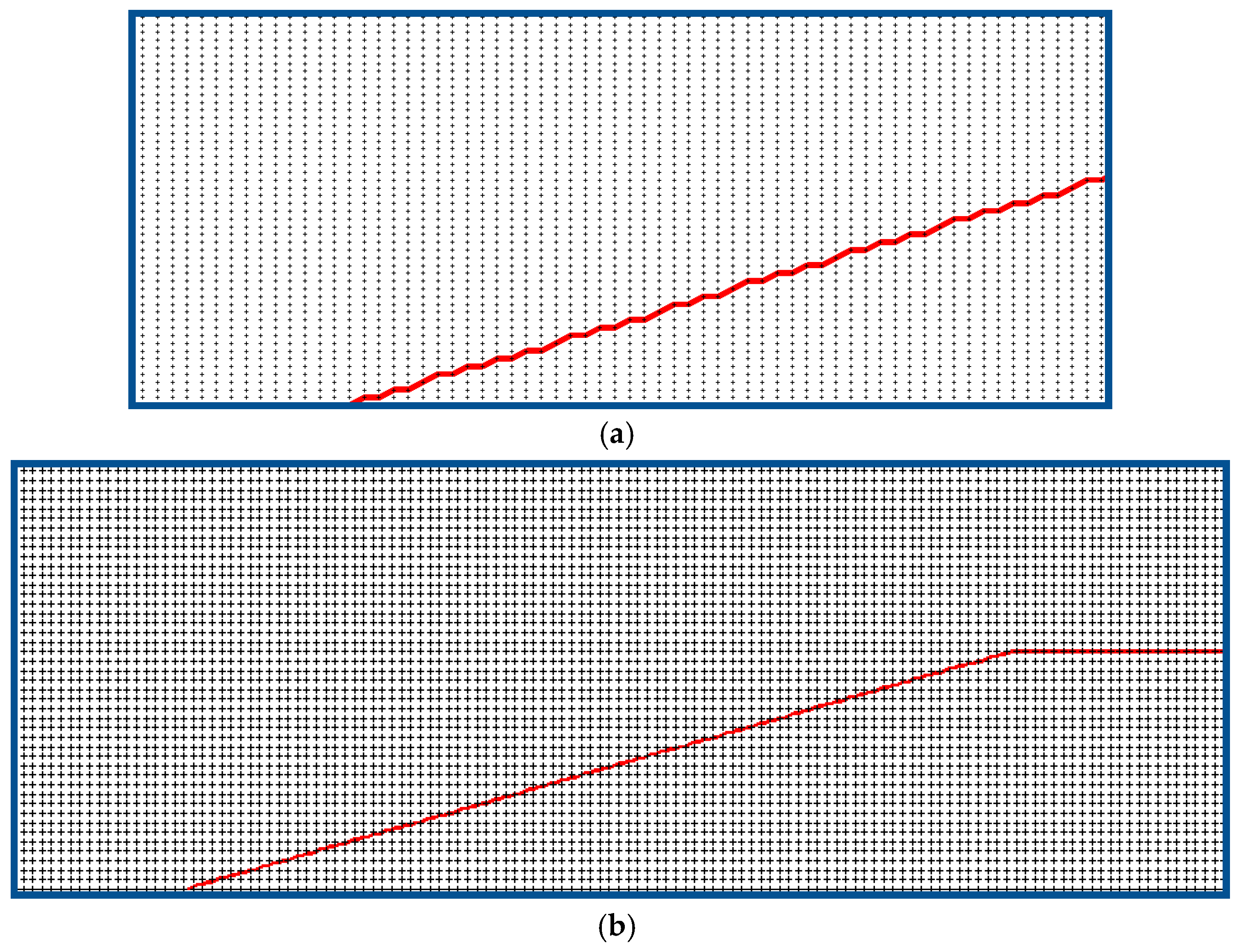



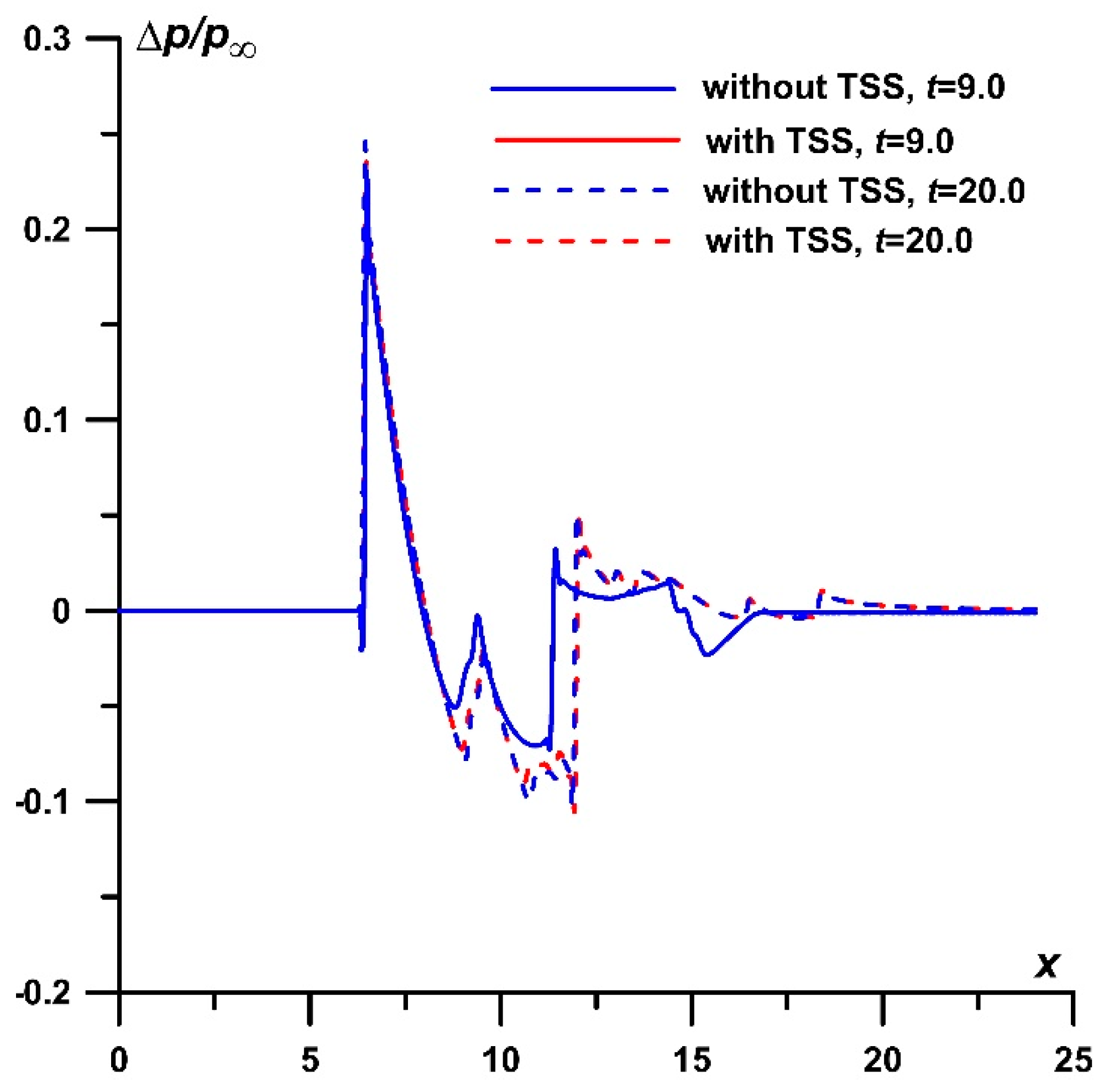
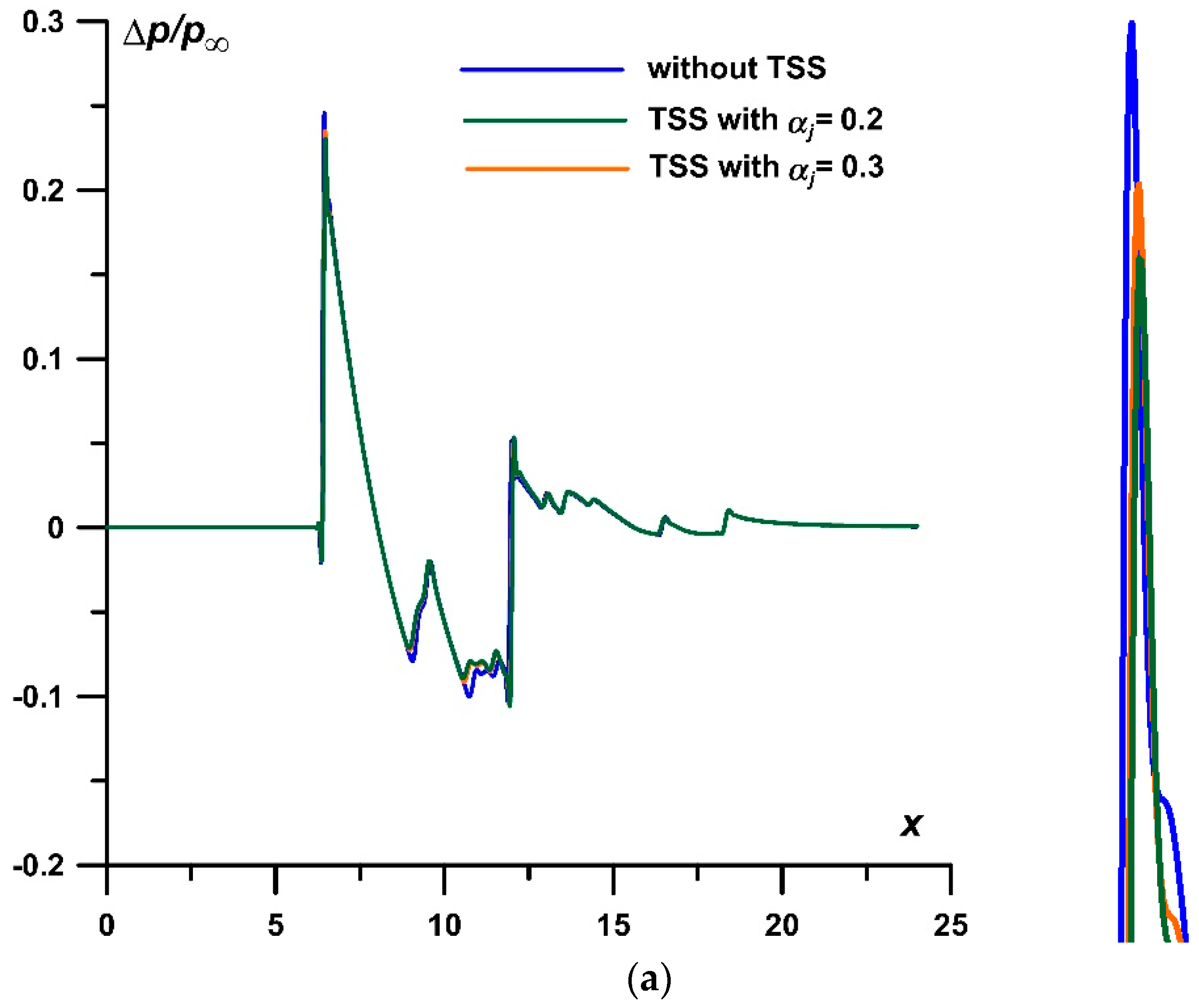


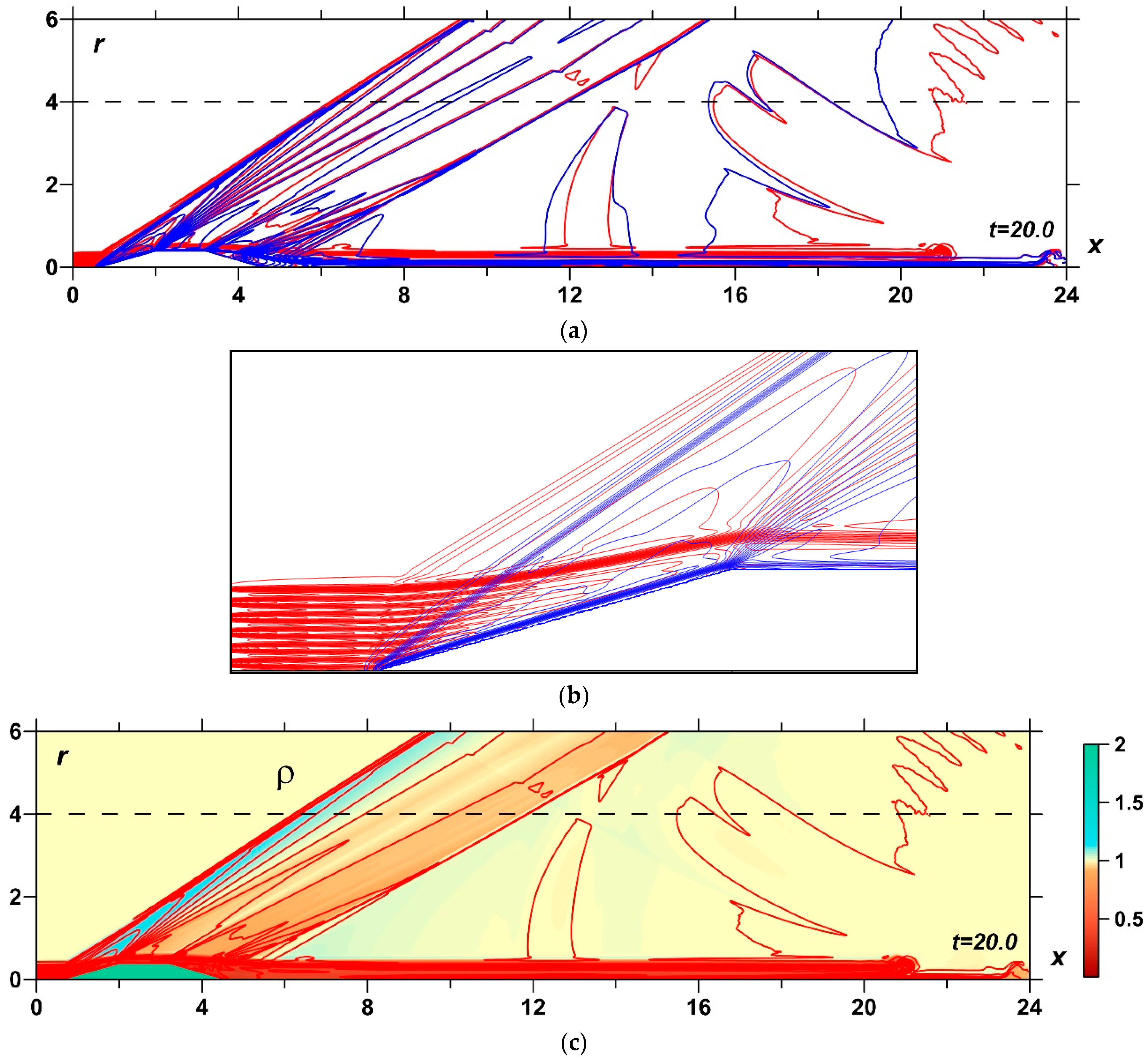



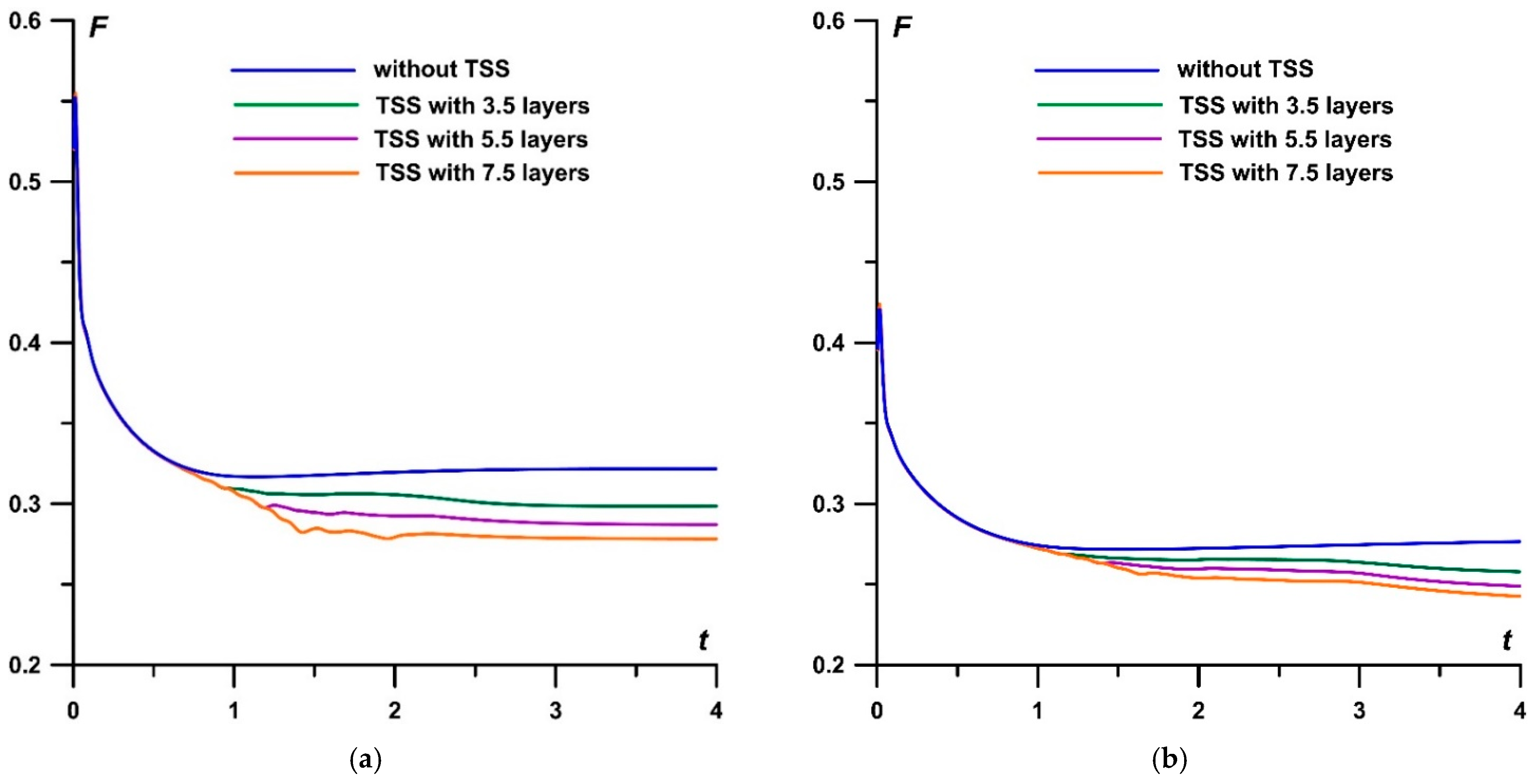
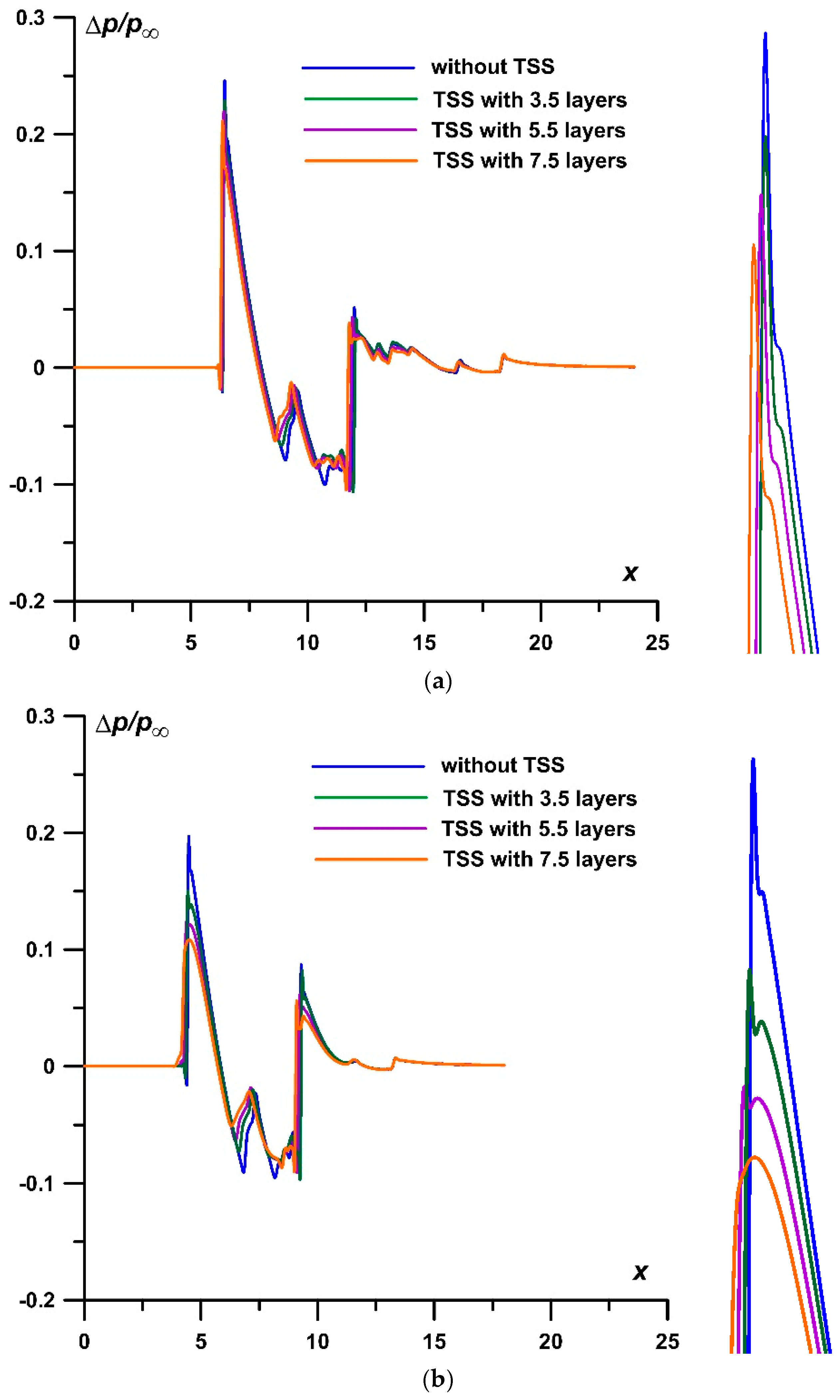
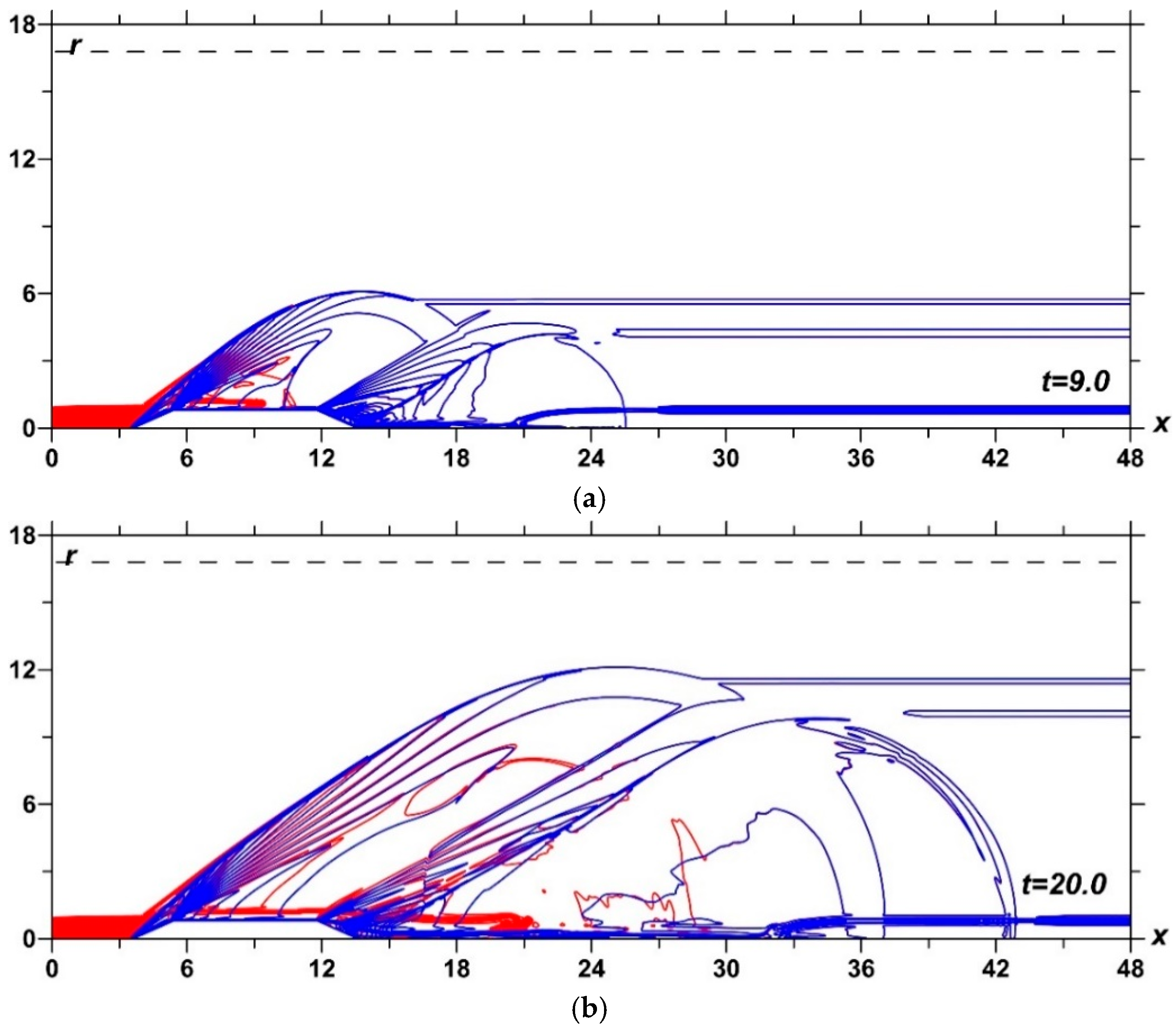
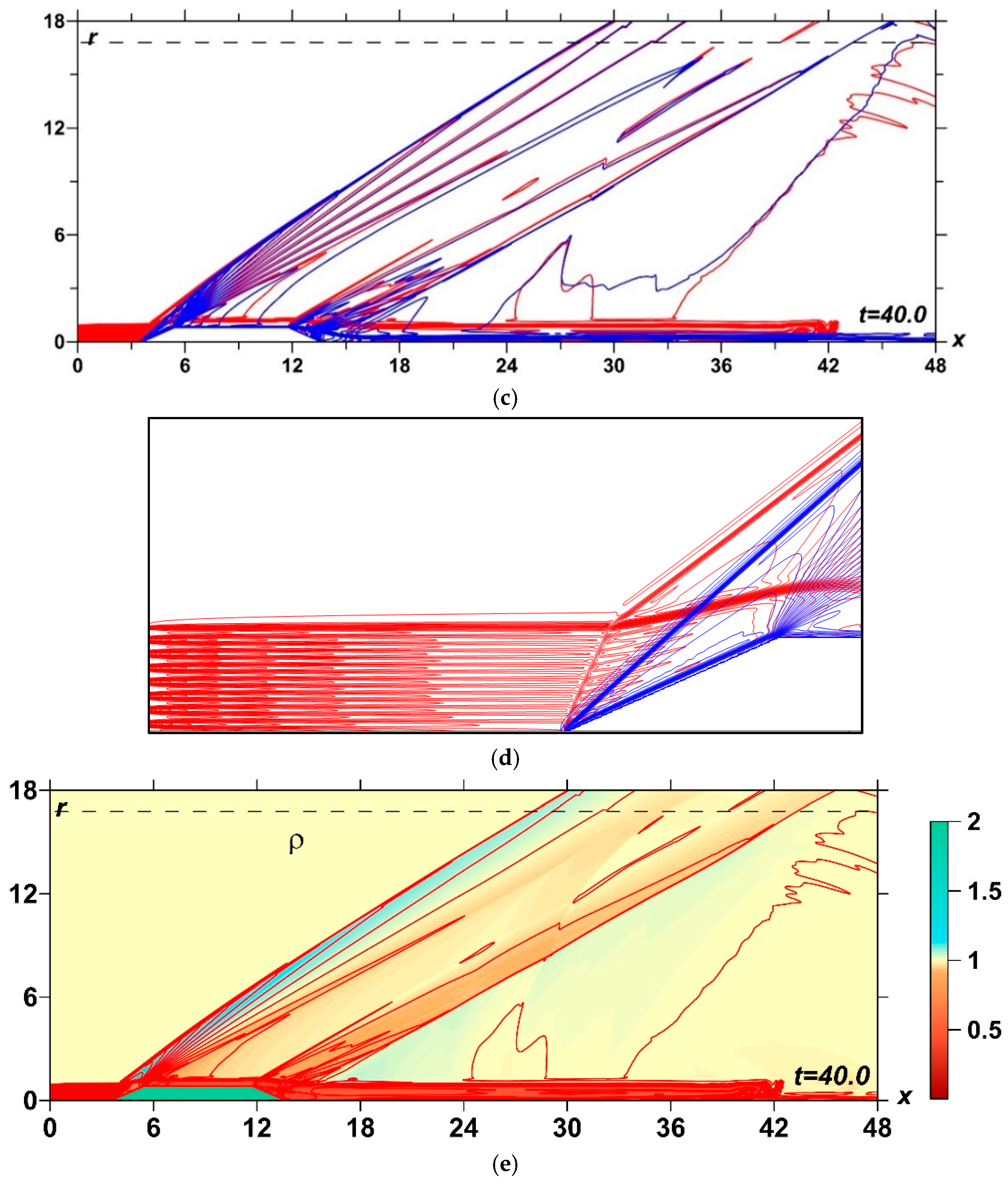
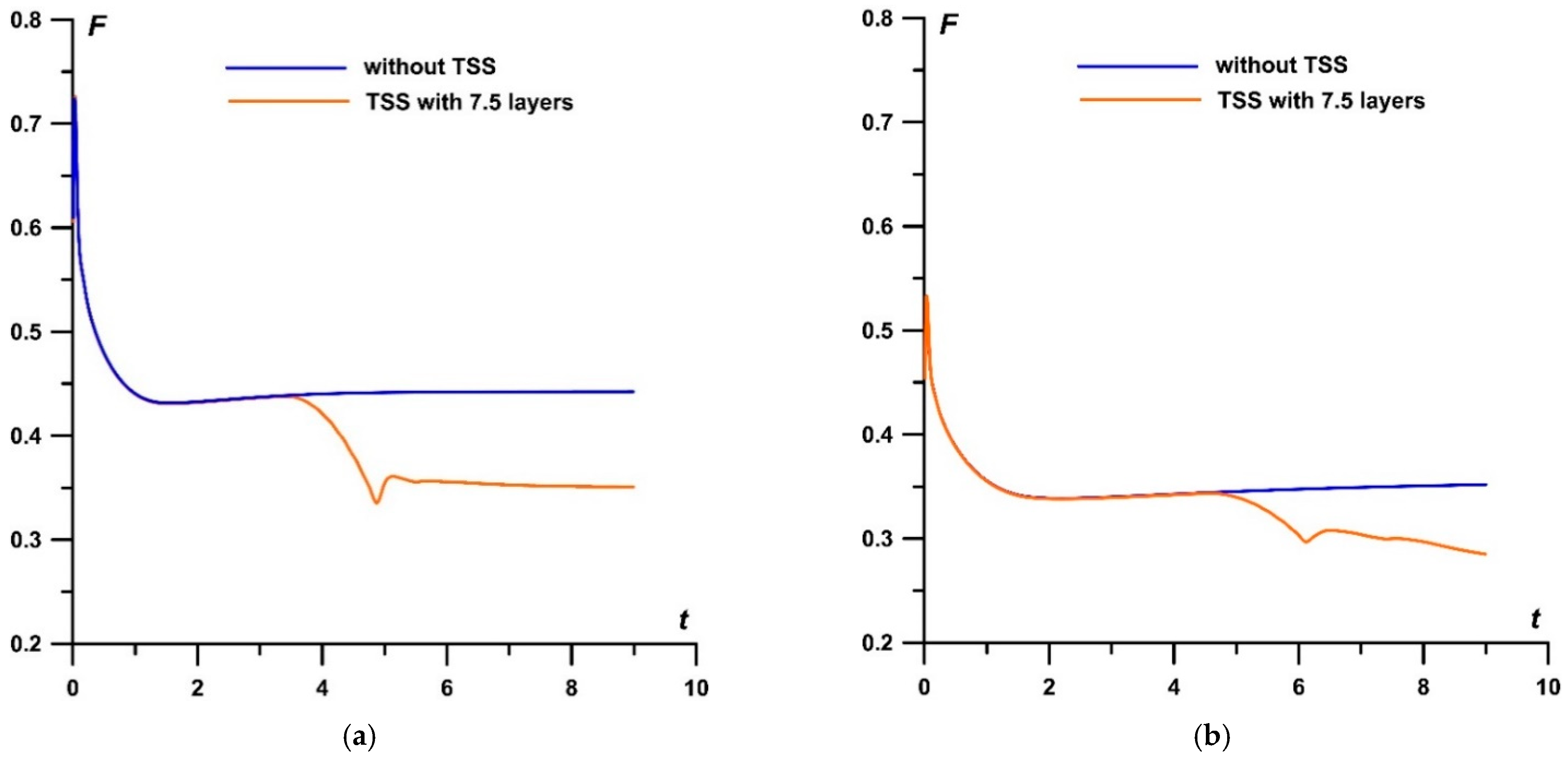

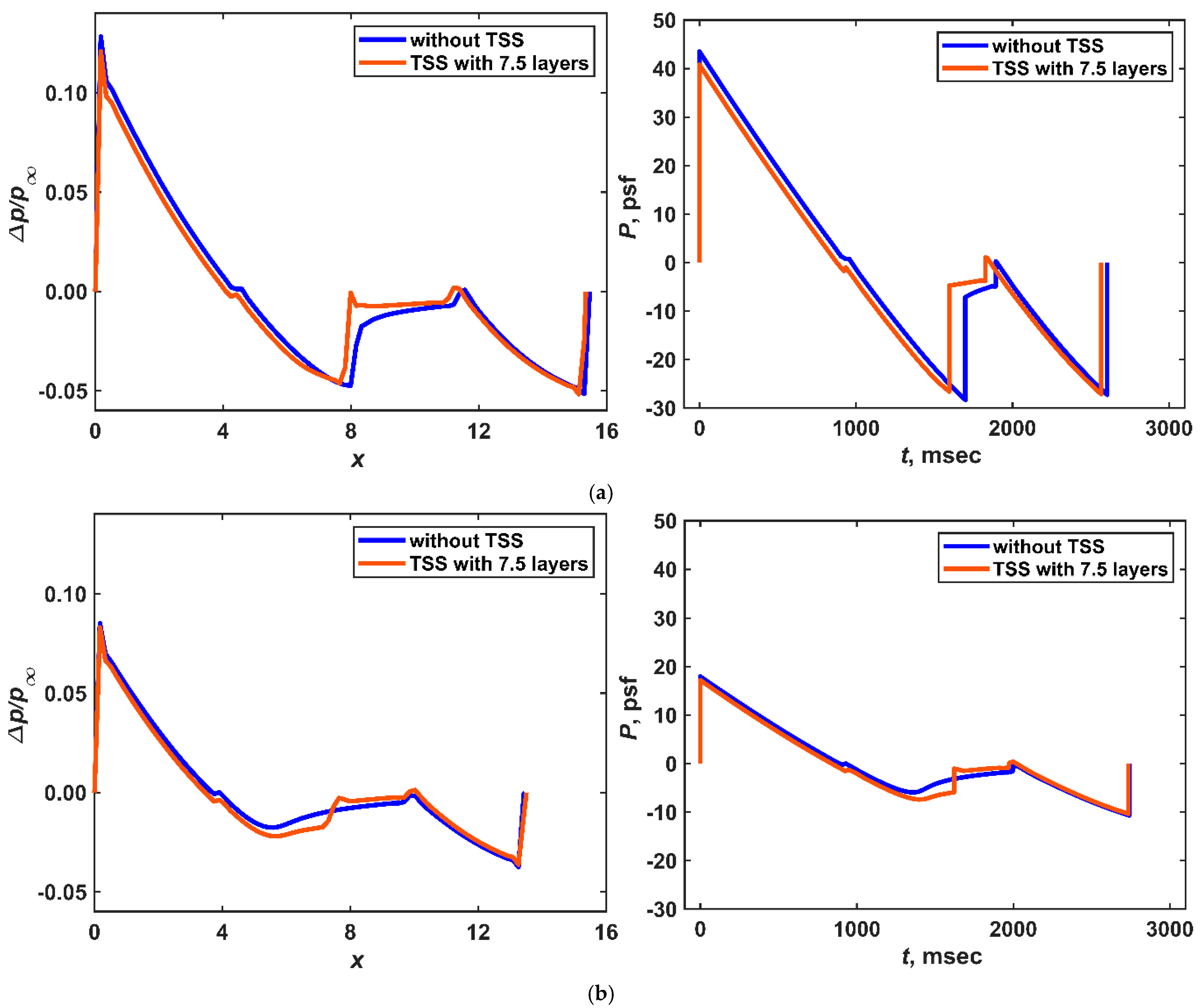
| Grid Number | hx, hr | Sizes |
|---|---|---|
| Grid1 | hx = 0.002 hr = 0.001 | 3000 × 2000 |
| Grid2 | hx = 0.004 hr = 0.002 | 1500 × 1000 |
| Grid3 | hx = 0.00606060606 hr = 0.00303030303 | 990 × 660 |
| Description | Definition | Non-Dimensional Value | Dimensional Value | Normalizing Value |
|---|---|---|---|---|
| Freestream Max number | M∞ | 2.0; 1.5 | ||
| Freestream pressure | p∞ | 0.2 | 26.5 kPa | pn = 132.5 kPa |
| Ratio of specific heats | γ | 1.4 | ||
| Maximal radius of AD body | R | 0.4 | 0.5 m | ln = 1.25 m |
| Length of the AD body | L | 4.0 | 5 m | ln = 1.25 m |
| The width of the layers in considered TSSs | rs | 0.04 | 0.05 m | ln = 1.25 m |
| Number of layers in different TSSs | N | 2.5; 3.5; 5.5; 7.5 | ||
| Rarefaction parameter in the layer j in different TSSs | αj | 0.15; 0.2; 0.25; 0.3 |
| Description | Definition | Non-Dimensional Value | Dimensional Value | Normalizing Value |
|---|---|---|---|---|
| Freestream Max number | M∞ | 2.0; 1.5 | ||
| Freestream pressure | p∞ | 0.2 | 26.5 kPa | pn = 132.5 kPa |
| Ratio of specific heats | γ | 1.4 | ||
| Maximal radius of AD body | R | 0.8 | 6.4 m | ln = 8 m |
| Length of the AD body | L | 10.0 | 80 m | ln = 8 m |
| The half-width of the layers in considered TSSs | rs | 0.04 | 0.32 m | ln = 8 m |
| Number of layers in different TSSs | N | 7.5 | ||
| Rarefaction parameter in the layer j in different TSSs | αj | 0.25 |
| Near-field Signatures Δp/p∞ | Ground Sound Pressure Impact, M∞ = 1.5 | Ground Sound Pressure Impact, M∞ = 2 |
|---|---|---|
| Without TSS | 163.62 dB | 166.11 dB |
| With TSS | 163.26 dB | 165.60 dB |
Disclaimer/Publisher’s Note: The statements, opinions and data contained in all publications are solely those of the individual author(s) and contributor(s) and not of MDPI and/or the editor(s). MDPI and/or the editor(s) disclaim responsibility for any injury to people or property resulting from any ideas, methods, instructions or products referred to in the content. |
© 2023 by the authors. Licensee MDPI, Basel, Switzerland. This article is an open access article distributed under the terms and conditions of the Creative Commons Attribution (CC BY) license (https://creativecommons.org/licenses/by/4.0/).
Share and Cite
Kravchenko, O.V.; Azarova, O.A.; Knight, D.D. Impact of a Thermally Stratified Energy Source Located in Front of a Pointed Cylinder Aerodynamic Model on the Pressure Signatures and PLdB Effect on the Ground. Appl. Sci. 2023, 13, 7927. https://doi.org/10.3390/app13137927
Kravchenko OV, Azarova OA, Knight DD. Impact of a Thermally Stratified Energy Source Located in Front of a Pointed Cylinder Aerodynamic Model on the Pressure Signatures and PLdB Effect on the Ground. Applied Sciences. 2023; 13(13):7927. https://doi.org/10.3390/app13137927
Chicago/Turabian StyleKravchenko, O. V., O. A. Azarova, and D. D. Knight. 2023. "Impact of a Thermally Stratified Energy Source Located in Front of a Pointed Cylinder Aerodynamic Model on the Pressure Signatures and PLdB Effect on the Ground" Applied Sciences 13, no. 13: 7927. https://doi.org/10.3390/app13137927
APA StyleKravchenko, O. V., Azarova, O. A., & Knight, D. D. (2023). Impact of a Thermally Stratified Energy Source Located in Front of a Pointed Cylinder Aerodynamic Model on the Pressure Signatures and PLdB Effect on the Ground. Applied Sciences, 13(13), 7927. https://doi.org/10.3390/app13137927








